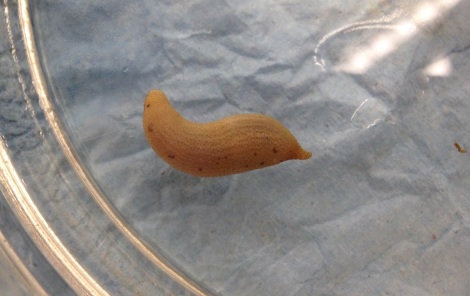At first glance, the trunk of an individual from Sipuncula has texture and shape akin to a peanut (see Figure 1), explaining its common name, “peanut worm”. Peanut worms belong to phylum Annelida despite their lack of setae and segmentation (Pechenik 2015). At rest, a typical peanut worm is about as big as a kidney bean. However, when it feeds, the peanut worm undergoes remarkable transformation; from the anterior of the worm, the introvert emerges, as in Figure 2. The introvert’s length in our specimen is about four times the trunk’s. According to Cutler (1994), in some species, the introvert can be ten times the length of the trunk!
Figure 1: Peanut worm at rest. (Photo Credit: Kyle Cox)
At its tip, the introvert contains the mouth. Tiny tentacles around the mouth possibly serve as chemoreceptors (Cutler 1994). Most importantly, the introvert and tentacles help the Sipunculan gather food. As deposit feeders, sipunculans ingest sediment rich in organic materials. Their menu includes bacteria, algae, protozoans, and small invertebrates found in the sediment (Maiorova & Adrianov 2013). Under dissecting scope, I can observe tiny pieces of food particles moving inside the introvert, with movement much like a conveyor belt.
Figure 2: Peanut worm with introvert fully extended. The introvert helps in feeding and respiration. (Photo Credit: Kyle Cox)
To my surprise, the anus is not at the posterior end of the animal. Instead, sipunculans arrange their anus at the anterior end of the trunk, closer to the introvert. This peculiar position of the anus suggests a sedentary or burrowing lifestyle where wastes need to be expelled through an opening so close to the mouth (Cutler 1994). I imagine that if the posterior end bore the anus instead, wastes would accumulate over time and contaminate the burrow.
I also noticed the introvert to be thin and feeble. So, I wondered if a more rigid introvert would help sipunculans feed more efficiently by allowing ingestion of larger amount of sediment. Surprisingly, some sipunculans benefit more from a thin introvert because they rely on diffusion for gas exchange. Ruppert & Rice (1995) classified sipunculans into three groups based on location of gas exchange. Depending on species, peanut worms can breathe through tentacles, introvert and tentacles, or trunk. In lab, my specimen of genus Phascolosoma fell into the group that performs respiration with tentacles and introvert. This mode of respiration reflects the habitat and behavior of the organism (Ruppert & Rice 1995). As this peanut worm burrows in sediment with low oxygen content, it can extend the introvert to gather both nutrients and gases. It makes sense then that the introvert’s body wall is thinner than the trunk’s body wall. This arrangement allows smoother diffusion of gases across the thin introvert, while the thicker trunk can burrow deep into the sediment in order to anchor and protect the retractable introvert.
Interestingly, because their respiration relies only on diffusion through a thin body wall, sipunculans may not require high metabolism rate (Cutler 1994). Lower metabolism rate makes sense to me because peanut worms often live inside burrow, having to expend little energy to actively move around and look for food. Perhaps the sedentary and timid lifestyle reduces their need for more developed respiratory and circulatory systems.
References
Cutler, E. B. (1994). The Sipuncula: Their systematics, biology, and evolution. Ithaca: Comstock Pub. Associates.
Maiorova, A. S., & Adrianov, A. V. (2013). Peanut worms of the phylum Sipuncula from the Sea of Japan with a key to species. Deep Sea Research Part II: Topical Studies in Oceanography, 86-87(SI), 140-147.
Pechenik, J. A. (2015). The Annelids. In Biology of the Invertebrates (pp. 314-318). New York, NY: McGraw-Hill.
Ruppert, E. E., & Rice, M. E. (1995). Functional Organization of Dermal Coelomic Canals in Sipunculus nudus (Sipuncula) with a Discussion of Respiratory Designs in Sipunculans. Invertebrate Biology, 114(1), 51-63.

